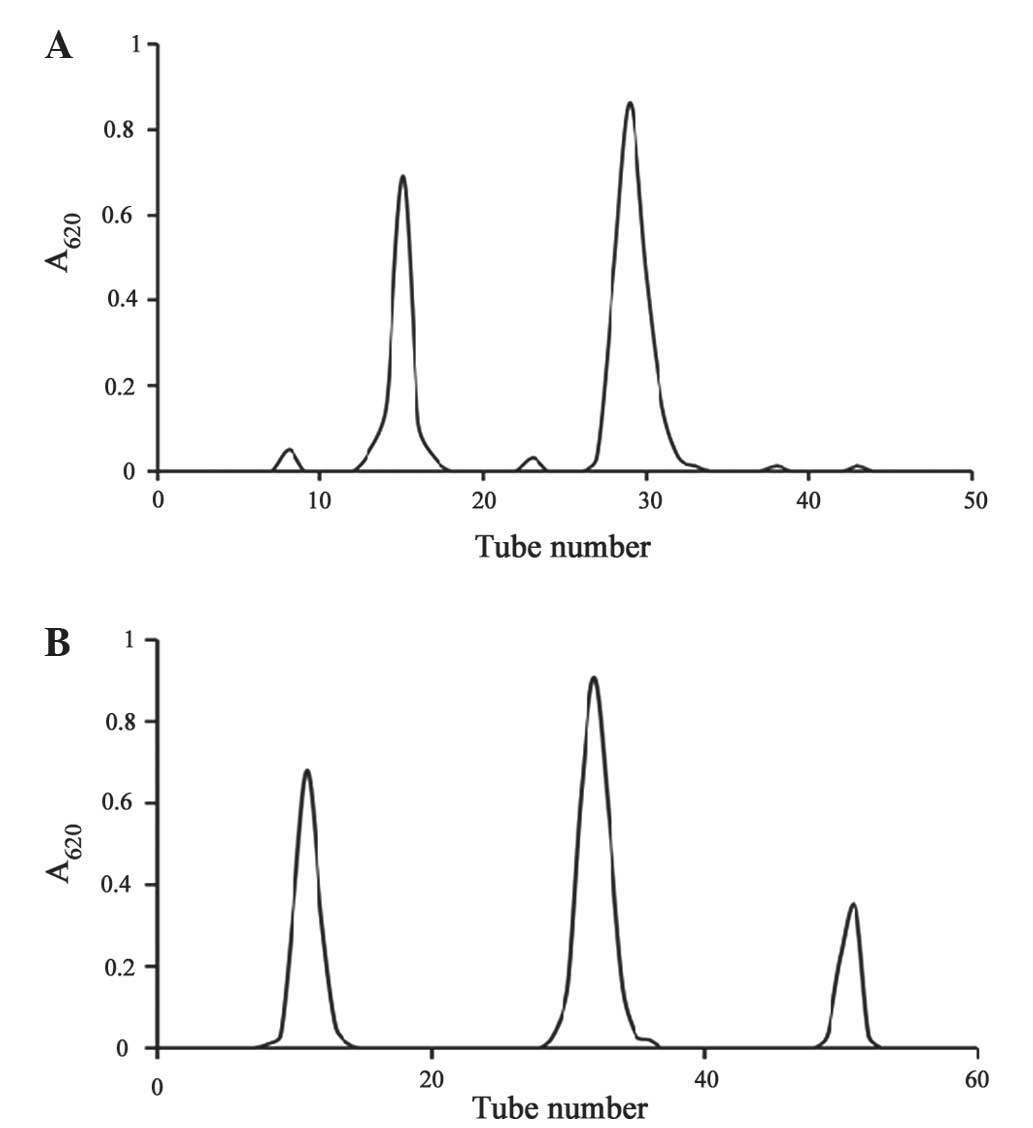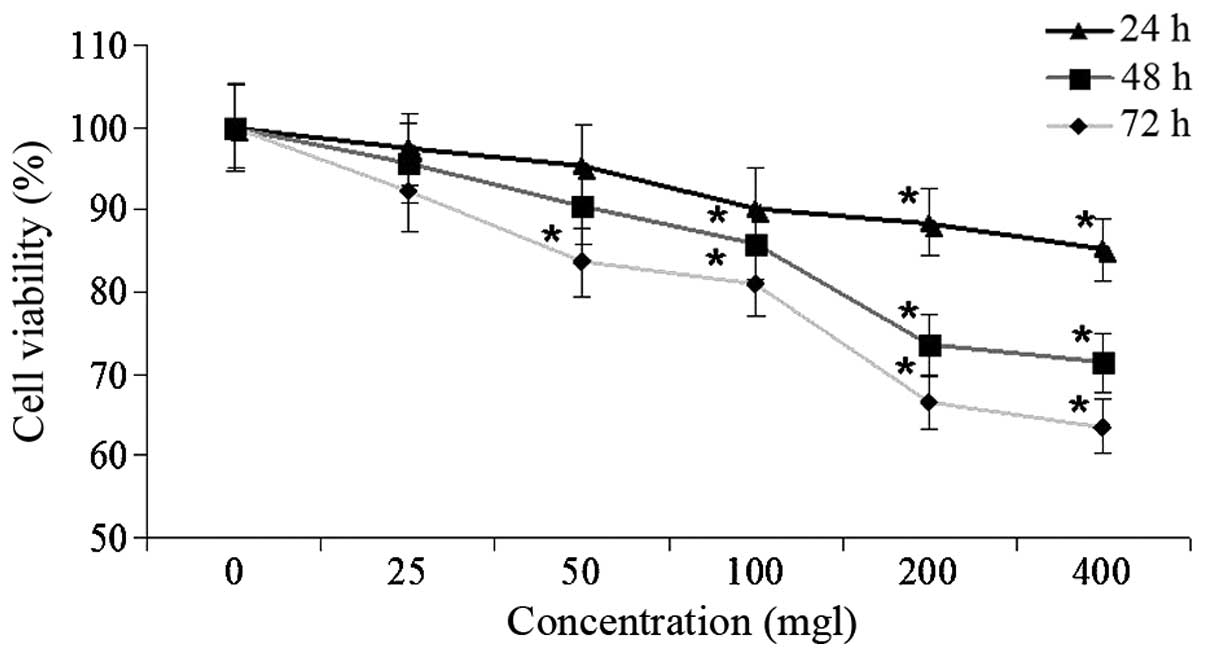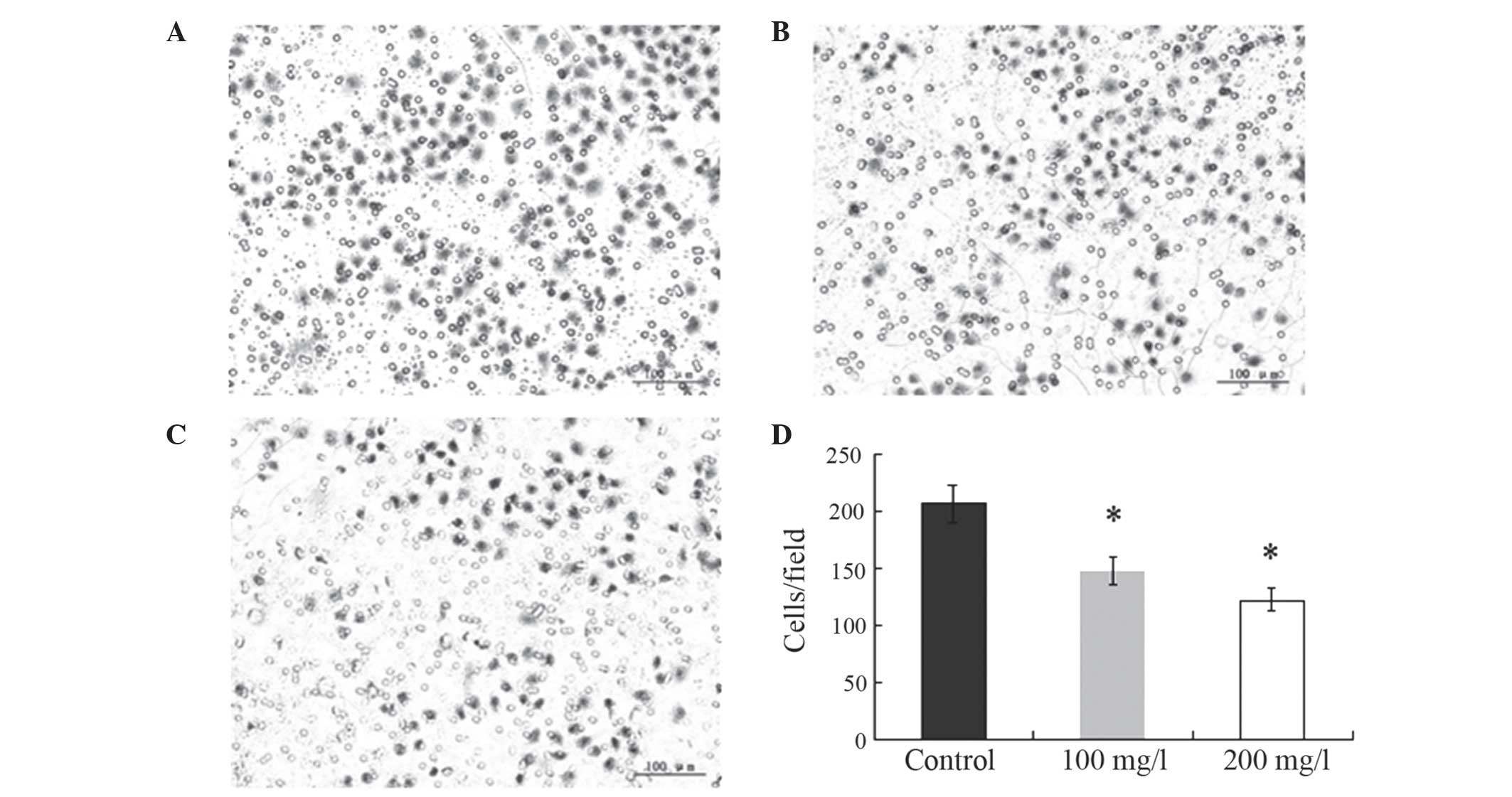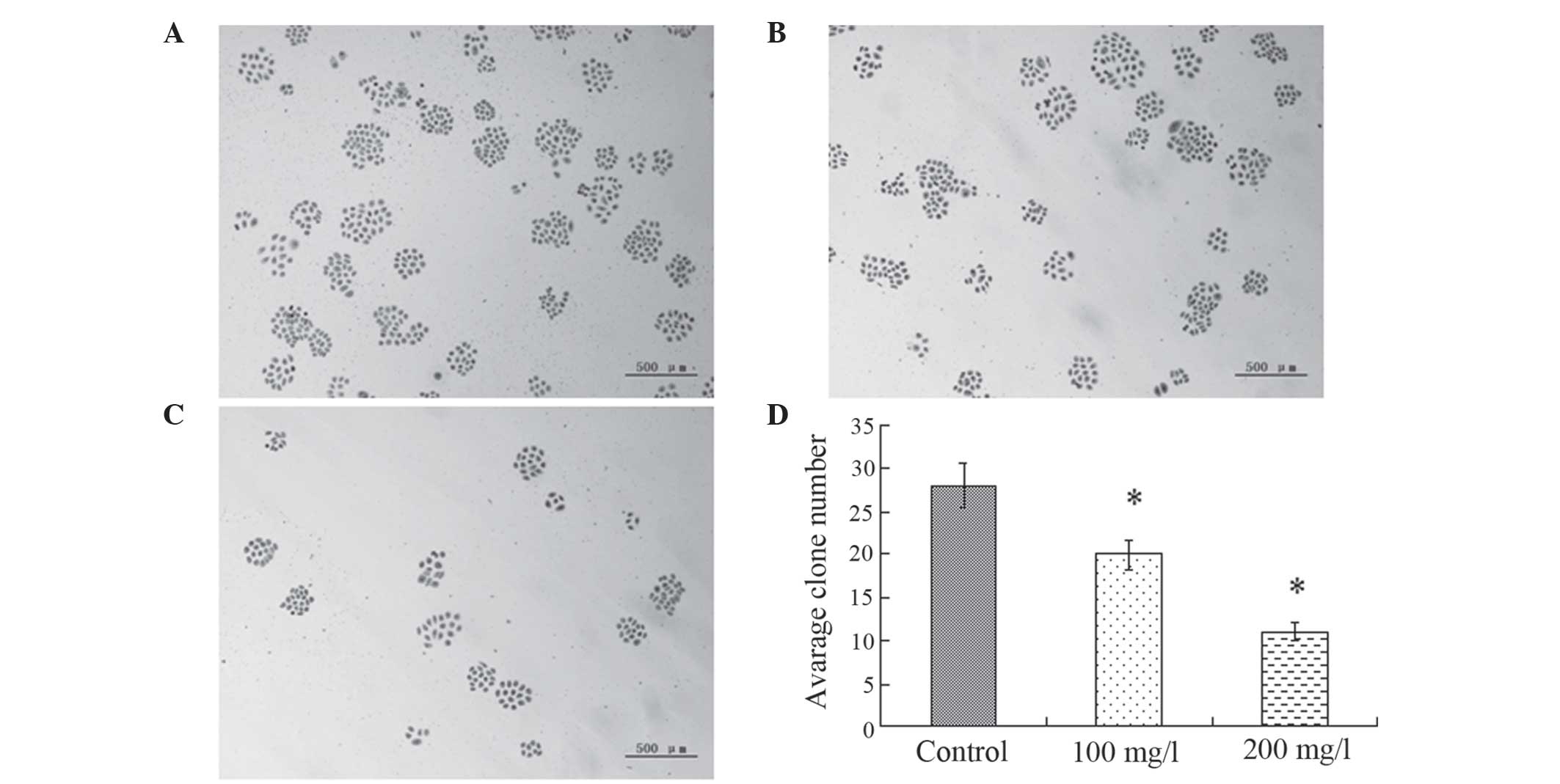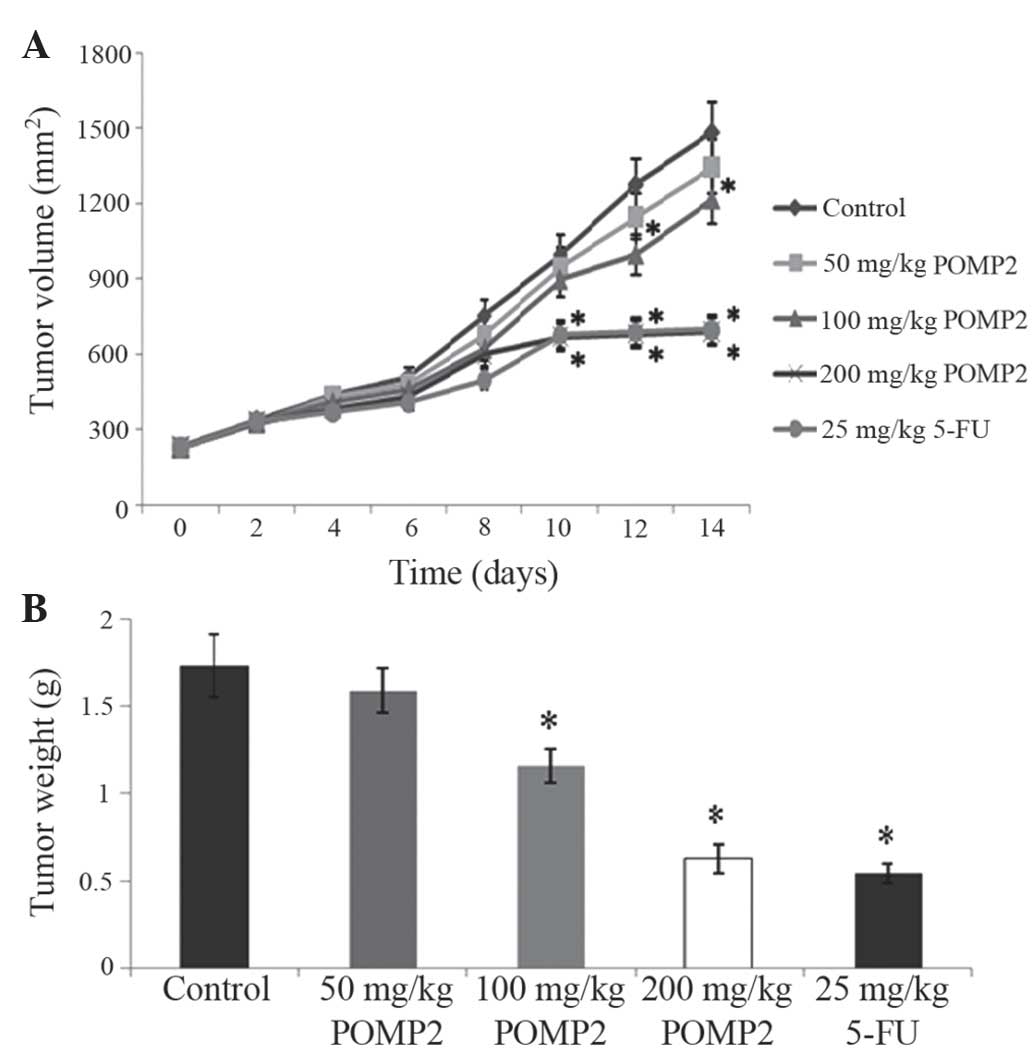Introduction
Gastric cancer is one of the most prevalent types of
cancer and is the second leading cause of cancer-associated
mortality worldwide, with approximately one million novel cases
diagnosed annually (1–3). Gastric cancer is highly prevalent in
Asia, particularly in China, Japan and Korea, as well as in Eastern
Europe and parts of Central and South America (4); however, a marked decline has been
reported in the incidence and mortality of gastric cancer (5). There are two major types of gastric
adenocarcinoma: Intestinal and diffuse. The pathogenesis of
intestinal gastric adenocarcinoma was reported to be a progression
from chronic gastritis to gastric atrophy and dysplasia through
multiple steps, whereas the pathogenesis of diffuse-type gastric
cancer remains to be fully elucidated (6). Currently, the most widely accepted
cause for diffuse-type gastric cancer is Helicobacter pylori
infection (6). Conventional
treatment options for gastric cancer include pharmacotherapy,
surgical resection, chemotherapy and radiation therapy. Surgical
resection remains the only curative treatment option; however, it
may only be performed in a small subgroup of patients (7,8).
Furthermore, even post surgery, numerous patients will experience
disease recurrence and succumb within a few months or years
(8). In addition, the majority of
chemotherapeutic drugs currently on the market induce various side
effects. Therefore, the production of effective and non-toxic
biological drugs is urgently required.
Mushrooms have been utilized as edible and medicinal
resources; numerous bioactive molecules have been identified from
their fruit body and cultured mycelium, which exhibit various
biological activities, including antitumor and immunomodulating
properties (9,10). Polysaccharides possess the highest
potential of the mushroom-derived substances that exhibit antitumor
properties (10,11). Polysaccharides are polymers
comprised of monosaccharides linked together through glycosidic
bonds (12). Over the past few
decades, numerous types of antitumor polysaccharides have been
identified from various sources and the mechanisms underlying their
activity have been elucidated. More recent research has focused on
identifying novel polysaccharides (13–16).
Pleurotus ostreatus is a common edible mushroom, which is
cultured commercially around the world for food. It is frequently
used in Chinese, Japanese and Korean cookery, due to its flavor,
high nutritional value and various medicinally beneficial effects
(17,18). Previous studies have demonstrated
that polysaccharides extracted from Pleurotus ostreatus
possess antitumor properties (19,20);
however, to the best of our knowledge no studies regarding the
antitumor activity of Pleurotus ostreatus mycelia
polysaccharides on gastric cancer have been published.
The aim of the present study was to extract
polysaccharides from Pleurotus ostreatus mycelia, which had
been harvested from submerged cultures, and analyze their antitumor
effects on gastric cancer in vitro and in vivo. The
present study aimed to provide a scientific basis for research and
reasonable application of polysaccharides in biological drugs.
Materials and methods
Materials and reagents
Pleurotus ostreatus (strain, beiping 11) was
maintained at the School of Life Science, Liaoning University
(Shenyang, China). MTT, penicillin, streptomycin and 5-fluorouracil
(5-FU) were purchased from Sigma-Aldrich (St. Louis, MO, USA).
Diethylaminoethyl (DEAE)-52 and Sephadex G-200 were purchased from
GE Healthcare (Uppsala, Sweden). Fetal bovine serum (FBS) and
RPMI-1640 media were purchased from Gibco Life Technologies (Grand
Island, NY, USA). All other chemical reagents were analytical
reagent grade, and were purchased from Sigma-Aldrich (St. Louis,
MO, USA) unless otherwise specified.
The BGC-823 human gastric cancer cells were obtained
from China Medical University (Shenyang, China). The cells were
cultured in RPMI-1640 medium supplemented with 10% FBS, penicillin
(100 U/ml) and streptomycin (100 µg/ml) at 37°C in a
humidified atmosphere containing 5% CO2. The cells were
harvested once they had reached the exponential growth phase. All
procedures involving animals and their care were conducted in
accordance with institutional guidelines for the Laboratory Animal
Care of Experimental Animal Center, China Medical University.
Fungal cultivation and extraction of
crude polysaccharides
The fungus was maintained at 25°C on a potato
dextrose agar plate for 6 days in an incubator. The active mycelium
were then scraped and transferred to a 250 ml Erlenmeyer flask
containing 100 ml of 200 g/l potato, 20 g/l glucose, 3 g/l yeast
extract, 1 g/l KH2PO4 and 1 g/l
MgSO4 with natural pH, and were cultured for 7 days at
25°C with 160 rpm agitation (13).
Pleurotus ostreatus mycelia were harvested from the liquid
medium by centrifuging the culture at 7,500 × g for 20 min at 4°C.
The mycelia were then dried in a 60°C oven. The dried fungal
biomass was ground and boiled in water for 4 h. The supernatant was
treated with four volumes of absolute ethanol (4:1 v/v) at 4°C for
12 h following centrifugation at 7,500 × g for 30 min in order to
extract the crude polysaccharides (10). The sediment was washed with
absolute ethanol following centrifugation at 7,500 × g for 20 min,
centrifuged and washed with absolute ethanol a further two times.
Protein was removed from the crude polysaccharide by Sevage method
(21) and then dialyzed with
distilled water. During the Sevage method, the polysaccharides were
mixed with Sevage reagent, 5:1 (v:v) CHCl3, n-BuOH and
stirred for 30 min. The mixture was then centrifuged at 7,500 × g
for 20 min, the upper polysaccharide solution was collected and
then dialyzed with distilled water (21). The solution was precipitated with
absolute ethanol and maintained at 4°C for 4 h. The precipitate was
freeze-dried following centrifugation at 7,500 × g for 20 min
(22).
Purification of Pleurotus ostreatus
mycelium polysaccharides
The crude polysaccharides (0.5 g) were dissolved in
distilled water (10 ml) and applied to a Sephadex G-200 column
(2.0×60.0 cm). The sample was eluted with 0.15 M sodium chloride at
a flow rate of 1 ml/min. Fractions were collected and carbohydrates
were measured using the anthronesulphuric acid method (23). In brief, 1 ml solution and 5 ml
anthrone reagent (0.1 g anthrone dissolved in 100 ml sulphuric acid
solution) were placed in a water bath (boiling) for 10 min, cooled
and measured using a UV-Vis spectrophotometer (GBC Cintra 20; GBC
Scientific Equipment, Melbourne, Australia) at 620 nm. The sugar
content was calculated using a standard curve created with
standardized glucose solutions. Further purification was conducted
using a DEAE-52 column (2.5×40.0 cm), sodium chloride solution was
used as the mobile phase and the samples were eluted in gradient
mode at a flow rate of 1 ml/min. The fractions were collected by
the automated fraction collector (AFC-3000 Automated Fraction
Collector; Thermo Fisher Scientific, Waltham, MA, USA) and measured
at 620 nm absorbance using the UV-Vis spectrophotometer, as
recommended by the anthronesulphuric acid method. The collected
fractions were dialyzed in distilled water for 24 h and
freeze-dried to obtain three types of purified polysaccharides:
Pleurotus ostreatus mycelium polysaccharides (POMP1, POMP2
and POMP3). An MTT assay was performed (as described in the
‘BGC-823 cell proliferation assay’ paragraph) to evaluate the
antitumor activity of the three polysaccharides, following which
POMP2 was selected for use in the subsequent studies.
Preliminary characterization of
polysaccharides
The molecular weight of POMP2 was determined by high
performance gel permeation chromatography (HPGPC) as described by
Miao et al (24) with minor
modifications. The sample was applied to an Agilent 1100 high
performance liquid chromatography system (Agilent Technologies,
Santa Clara, CA, USA) equipped with a TSK-GEL G3000 PWXL column
(7.8×300 mm). The sample was eluted with 0.1 mol/l
Na2SO4 solution at a flow rate of 0.5 ml/min
and was detected using a Refractive Index Detector-10A (Shimadzu
Corporation, Tokyo, Japan). The molecular weight was estimated with
reference to a calibration curve generated from a Dextran T-series
standard of known molecular weights (Mw; T-200, T-100, T-40, T-20
and T-10) and glucose (Mw, 180; Sigma-Aldrich) was used as a
standard (19). The sample was
detected using the UV spectrophotometer at 280 and 260 nm, in order
to confirm the absence of protein and nucleic acid.
BGC-823 cell proliferation assay
BGC-823 cells (1×104) were grown on
96-well plates (100 µl/well). Following a 24 h incubation,
non-adherent cells were removed by washing with RPMI-1640 medium
three times. The cultures were treated with a serial concentration
of POMP2 (25, 50, 100, 200 and 400 mg/l) and MTT (5 mg/ml) was
added to each well following 24, 48 or 72 h. The plate was
incubated for an additional 4 h at 37°C, following which the medium
was discarded. Subsequently, the formazan crystals were dissolved
in 150 µl dimethyl sulfoxide. In order to evaluate the
proliferative ability of the BGC-823 cells, MTT reduction was
determined by measuring the light absorbance of each well at 490 nm
using a microplate reader (680; Bio-Rad Laboratories, Inc.,
Hercules, CA, USA). All experiments were repeated in triplicate
(25).
Cell migration assay
Cell migration assays are frequently used to assess
the migration of metastatic cancer cells. The migration assay was
performed using a 6.5 mm-diameter Transwell chamber (Corning Life
Sciences, Tewksbury, MA, USA) with an 8.0 µm pore size. The
BGC-823 cells were trypsinized (0.25% trypsin) and resuspended in
serum-free RPMI-1640 following serum-starvation for 24 h.
Approximately 1×105 cells in serum-free RPMI-1640, with
100 or 200 mg/l POMP2, were counted and seeded into the upper
chamber of the Transwell and the lower chamber was filled with
RPMI-1640 supplemented with 10% FBS. Following incubation at 37°C
for 24 h, the cells on the inner surface of the upper chamber were
removed (6). The cells that had
penetrated through the chamber were fixed with methanol and stained
with Giemsa, according to the manufacturer’s instructions. The
cells were then visualized and counted under a microscope (Eclipse
TS100; Nikon, Tokyo, Japan); three fields of vision were selected
in each experimental condition (26).
Colony formation assay
BGC-823 cells (~1×103/well) were seeded
into different plates and allowed to adhere overnight. The cells in
the polysaccharide groups were incubated at 37°C with 100 or 200
mg/l POMP2 for 10 days, then each plate was washed three times with
phosphate-buffered saline (PBS). The colonies were fixed in
methanol for 20 min and stained with 0.5% crystal violet for 15
min. The colonies were further washed with PBS, observed under the
inverted microscope (Eclipse TS100) and images were captured using
a CCD color camera (KP-D20AU; Hitachi, Ibaraki, Japan) (27). Each assay was performed three times
in two independent experiments.
In vivo antitumor test
An in vivo antitumor assay was performed as
described by Miao et al (24), with minor modifications. Male
BALB/c (nu/nu) nude mice (4–6 weeks old, 20–22 g, 50 mice; Beijing
Vital River Experimental Animal Co., Ltd., Beijing, China) were
used to establish a BGC-823 xenograft tumor model. All of the mice
were housed in a pathogen-free facility and were given ad
libitum access to food and water in sterile conditions. The
mice in each group were subcutaneously inoculated with injections
of 2×106 BGC-823 cells/mouse and monitored daily for
tumor growth. Tumor size was determined using micrometer calipers
and mice with similar tumor sizes were randomly divided into five
groups, each containing five mice. The tumor bearing mice were
orally administrated POMP2 at the following doses: 50, 100 and 200
mg/kg. The control group were administered the same volume of PBS
and the positive control group were administered 25 mg/kg 5-FU
every other day for two weeks. Tumors were removed and weighed
after the mice had been sacrificed by cervical dislocation. The
tumor volume (TV) of each tumor was calculated using the following
formula: TV (mm3)=(a × b2)/2, where a (mm)
and b (mm) represent the longest and shortest tumor diameter,
respectively.
Statistical analysis
All statistical analyses were performed using SPSS
18.0 (International Business Machines, Armonk, NY, USA). The data
are presented as the mean ± standard deviation. One-way analysis of
variance was used to perform statistical comparisons. Randomized
block analysis of variance and the Students-Newman-Keuls method
were selected for intergroup comparisons. P<0.05 was considered
to indicate a statistically significant difference between
values.
Results
Isolation, purif ication and
characterization of polysaccharide
The crude polysaccharides extracted from the
mycelium of Pleurotus ostreatus were collected and
sequentially purified through Sephadex G200 and DEAE-52 columns. As
shown in Fig. 1, three fractions:
POMP1, POMP2 and POMP3, were separated. The main fraction, POMP2,
was selected for subsequent analyses due to its higher activity of
antiproliferation measured by MTT method (data not shown). POMP2
appeared as a white powder. The average molecular weight of POMP2
was calculated as 29 kDa by HPGPC, according to a calibration curve
with standard dextran and glucose. No absorbance was detected by a
spectrophotometer at 280 and 260 nm, thus indicating that the
preparation of POMP2 contained no protein or nucleic acids and was
a homogeneous polysaccharide.
In vitro antitumor activity
BGC-823 cells were incubated with various
concentrations of POMP2 (25, 50, 100, 200 and 400 mg/l) for various
durations (24, 48 and 72 h). Subsequently, cell survival was
measured using the MTT method. As shown in Fig. 2, POMP2 inhibited the proliferation
of BGC-823 cells in a time- and concentration-dependent manner;
significant inhibition was exhibited at various concentrations
following 24, 48 and 72 h of treatment compared with the control
group (P<0.05). At the highest concentration (400 mg/l), the
rate of inhibition was 35.6% following 72 h.
Invasiveness of BGC-823 cells is
inhibited by POMP2
Metastasis is the predominant cause of
cancer-associated mortality. The Transwell migration assay is
suitable for cancer cells and is used to evaluate the invasive and
migratory ability of cells into distal organs. To investigate the
effects of POMP2 on the migration of BGC-823 cells, the migratory
behavior of the cells was determined using a Transwell assay. The
number of POMP2-treated cells that were able to migrate across the
membrane was markedly reduced compared with the control cells
(Fig. 3A–C). These results suggest
that POMP2 was able to significantly inhibit the invasiveness of
BGC-823 cells (P<0.05) (Fig.
3D).
Treatment with POMP2 reduces colony
formation
The number of BGC-823 colonies formed in the
presence of POMP2 was significantly reduced compared with the
negative control group; representative images are shown in Fig. 4. When the cells were treated with
100 and 200 mg/l POMP2 for 72 h there was a highly significant
reduction in colony formation compared with the negative control
group (*P<0.05) (Fig.
4D).
Effects of bioactive POMP2 on tumor
growth in vivo
Based on the in vitro results of the present
study, POMP2 was used for in vivo antitumor experiments to
further explore whether it possessed a growth inhibitory effect on
tumor growth in mice. The effects of POMP2 on the growth of primary
tumor xenografts in nude mice were examined. All mice survived the
experiment and the tumor xenografts were shown to be successful. As
shown in Fig. 5, significant
decreases in tumor weight and volume were observed following
treatment with 100 and 200 mg/kg POMP2 compared with the control
group (P<0.05). These results suggested that POMP2 may be able
to potently suppress tumor growth in mice bearing BGC-823
xenografts.
Discussion
Gastric cancer is a major global public health
problem, particularly in Asian and Eastern European countries,
where the rate of incidence is 6–8 times greater than in Western
countries (28). Even in patients
with operable tumors, the proportion of long-term survivors is ~25%
worldwide (29). Chemotherapy is
widely used to treat advanced gastric cancer (30). 5-FU is currently considered an
important drug in clinical chemotherapeutic treatment for
gastrointestinal cancers, but it is not efficient for gastric
cancer therapy when it is used alone (31). Furthermore, the presence of gastric
cancer cells that are resistant to current chemotherapeutic drugs
results in a lack of curative effects (32). The use of natural products as
biological drugs may be an effective method for treating gastric
cancer (33). In particular,
polysaccharides extracted from mushrooms have gained attention.
Numerous polysaccharides have been isolated from the fruit body of
fungi; however, it may take more time and energy to obtain the
fruit body, resulting in a lower efficiency compared with
extracting polysaccharides from mycelia (34). With regards to antitumor mechanism,
previous studies have indicated that polysaccharides were able to
directly inhibit tumor activity (35) and some reports have demonstrated
that numerous types of polysaccharide exhibit significant
apoptosis-inducing activities (11,36).
In addition, previous studies have indicated that polysaccharides
may inhibit cancer by stimulating the immune system (13,32).
Pleurotus ostreatus is a well-known,
traditional edible fungus that is consumed in China due to its
nutritional properties. Previous studies have shown that
Pleurotus ostreatus contains numerous classes of compounds,
including extracellular enzymes, phenols, flavoring agents and
polysaccharides (37).
Polysaccharides may be obtained from both the fruit body and the
mycelia of fungi (38). Due to the
limited supply of fruit body, cultivation of its mycelial form in
controlled conditions may be another resource of polysaccharides
(39). The anticancer
polysaccharide fractions may be clinically used to treat various
types of cancer. However, there are currently few reports of
polysaccharides isolated from Pleurotus ostreatus mycelia
exhibiting antitumor properties in gastric cancer. The present
study successfully isolated and purified POMP2 from Pleurotus
ostreatus mycelia and char-acterized its anticancer properties.
The inhibitory effects of POMP2 on gastric cancer cells were
investigated in vitro and in vivo. Results of an MTT
assay demonstrated that POMP2 significantly inhibited the
proliferation of BGC-823cells, which indicated that POMP2 had a
cytotoxic effect on BGC-823 cells. The colony formation assay is
another in vitro cell survival assay, based on the ability
of a single cell to grow into a colony (40). In the present study, 100 mg/l POMP2
resulted in a significant reduction in colony formation in BGC-823
cells. The transition of tumor cells from benign tumor growth to
malignancy is characterized by their ability to invade the
surrounding tissue (41).
Metastasis is one of the predominant causes of cancer-associated
mortality (41); therefore, the
present study investigated the migratory ability of BGC-823 cells
treated with POMP2. A Transwell migration assay was used to assess
the ability of POMP2 to inhibit metastasis of cancer cells and the
results demonstrated that cells treated with POMP2 for 24 h
exhibited significantly reduced migration, as compared with the
control cells.
Based on the initial screening results, the present
study investigated the antitumor activity of POMP2 in BGC-823
cancer cell-engrafted mice. The results demonstrated that tumor
weight and volume were markedly suppressed following POMP2
treatment for 2 weeks in tumor-bearing mice. The results of these
in vivo and in vitro studies provided evidence for
the potential use of POMP2 as an anticancer agent against gastric
cancer (24).
In conclusion, the results of the present study
indicated that POMP2, a polysaccharide isolated from Pleurotus
ostreatus mycelia, is a natural product that may inhibit
gastric cancer cell growth in vitro and in vivo, in a
dose- and time-dependent manner. Based on these results, it may be
speculated that POMP2 could be used as a potential therapeutic
agent against gastric cancer. The present study is a preliminary
study that aimed to prove the antitumor effects of POMP2;
therefore, further research regarding the precise mechanisms
underlying its anticancer actions is required.
Acknowledgments
The present study was supported by the National
Natural Science Foundation of China (grant no. 31240005), the
Program for Liaoning Excellent Talents in University (grant no.
LJQ2013002), the Agriculture Research Program of Science and
Technology Department of Liaoning Province, China (grant nos.
2011211001 and 2009209001) the Startup Foundation for Doctors of
Liaoning University and the Scientific Research Fund of Liaoning
Provincial Education Department (grant no. L2014007).
Abbreviations:
|
POMP2
|
Pleurotus ostreatus mycelium
polysaccharides 2
|
|
MTT
|
3-(4,5-dimethylthiazol-2-yl)-2,5-dipheny ltetrazolium bromide
|
|
5-FU
|
5-fluorouracil
|
|
FBS
|
fetal bovine serum
|
References
|
1
|
Jemal A, Bray F, Center MM, et al: Global
cancer statistics. CA Cancer J Clin. 61:69–90. 2011. View Article : Google Scholar : PubMed/NCBI
|
|
2
|
Shiotani A, Cen P and Graham DY:
Eradication of gastric cancer is now both possible and practical.
Semin Cancer Biol. 23:492–501. 2013. View Article : Google Scholar : PubMed/NCBI
|
|
3
|
Melton SD, Genta RM and Souza RF:
Biomarkers and molecular diagnosis of gastrointestinal and
pancreatic neoplasms. Nat Rev Gastroenterol Hepatol. 7:620–628.
2010.PubMed/NCBI
|
|
4
|
Correa P and Houghton J: Carcinogenesis of
Helicobacter pylori. Gastroenterology. 133:659–672. 2007.
View Article : Google Scholar : PubMed/NCBI
|
|
5
|
Ferlay J, Shin HR, Bray F, et al:
Estimates of worldwide burden of cancer in 2008: GLOBOCAN 2008. Int
J Cancer. 127:2893–2917. 2010. View Article : Google Scholar
|
|
6
|
Crew KD and Neugut AI: Epidemiology of
gastric cancer. World J Gastroenterol. 12:354–362. 2006.PubMed/NCBI
|
|
7
|
Shi Y and Zhou Y: The role of surgery in
the treatment of gastric cancer. J Surg Oncol. 101:687–692. 2010.
View Article : Google Scholar : PubMed/NCBI
|
|
8
|
Yamashita K, Sakuramoto S, Nemoto M, et
al: Trend in gastric cancer: 35 years of surgical experience in
Japan. World J Gastroenterol. 17:3390–3397. 2011. View Article : Google Scholar : PubMed/NCBI
|
|
9
|
Wasser SP: Medicinal mushrooms as a source
of antitumor and immunomodulating polysaccharides. Appl Microbiol
Biotechnol. 60:258–274. 2002. View Article : Google Scholar : PubMed/NCBI
|
|
10
|
Cao X, Liu R, Liu J, et al: A novel
polysaccharide from Lentinus edodes Mycelia exhibits potential
antitumor activity on laryngeal squamous cancer cell line Hep-2.
Appl Biochem Biotechnol. 171:1444–1453. 2013. View Article : Google Scholar : PubMed/NCBI
|
|
11
|
Zhang M, Cui SW, Cheung PCK and Wang Q:
Antitumor polysaccharides from mushrooms: A review on their
isolation process, structural characteristics and antitumor
activity. Trends Food Sci Technol. 18:4–19. 2007. View Article : Google Scholar
|
|
12
|
Zong A, Cao H and Wang F: Anticancer
polysaccharides from natural resources: A review of recent
research. Carbohydr Polym. 90:1395–1410. 2012. View Article : Google Scholar : PubMed/NCBI
|
|
13
|
Liu JJ, Huang TS, Hsu ML, et al: Antitumor
effects of the partially purified polysaccharides from Antrodia
camphorata and the mechanism of its action. Toxicol Appl Pharmacol.
201:186–193. 2004. View Article : Google Scholar : PubMed/NCBI
|
|
14
|
Ahmad MS, Ahmad S, Gautam B and Afzal M:
Antigenotoxic and anticlastogenic potential of Agaricus bisporus
against MMS induced toxicity in human lymphocyte cultures and in
bone marrow cells of mice. Egypt J Med Hum Genet. 14:395–402. 2013.
View Article : Google Scholar
|
|
15
|
Lavi I, Friesem D, Geresh S, et al: An
aqueous polysaccharide extract from the edible mushroom Pleurotus
ostreatus induces anti-proliferative and pro-apoptotic effects on
HT-29 colon cancer cells. Cancer Lett. 244:61–70. 2006. View Article : Google Scholar : PubMed/NCBI
|
|
16
|
Gao T, Bi H, Ma S and Lu J: Structure
elucidation and antioxidant activity of a novel α-(1-->3),
(1-->4)-D-glucan from Aconitum kusnezoffii Reichb. Int J Biol
Macromol. 46:85–90. 2010. View Article : Google Scholar
|
|
17
|
Kalmis E, Azbar N, Yildiz H and Kalyoncu
F: Feasibility of using olive mill effluent (OME) as a wetting
agent during the cultivation of oyster mushroom, Pleurotus
ostreatus, on wheat straw. Bioresour Technol. 99:164–169. 2008.
View Article : Google Scholar
|
|
18
|
Jayakumar T, Thomas PA and Geraldine P:
Protective effect of an extract of the oyster mushroom, Pleurotus
ostreatus, on antioxidants of major organs of aged rats. Exp
Gerontol. 42:183–191. 2007. View Article : Google Scholar
|
|
19
|
Tong H, Xia F, Feng K, et al: Structural
characterization and in vitro antitumor activity of a novel
polysaccharide isolated from the fruiting bodies of Pleurotus
ostreatus. Bioresour Technol. 100:1682–1686. 2009. View Article : Google Scholar
|
|
20
|
Facchini JM, Alves EP, Aguilera C, et al:
Antitumor activity of Pleurotus ostreatus polysaccharide fractions
on Ehrlich tumor and Sarcoma 180. Int J Biol Macromol. 68:72–77.
2014. View Article : Google Scholar : PubMed/NCBI
|
|
21
|
Staub AM: Removal of proteins: Sevag
Method. Methods Carbohydr Chem. Whistler RL: 5. Academic Press,
Inc; New York: pp. 5–6. 1965
|
|
22
|
Jeff IB, Yuan X, Sun L, et al:
Purification and in vitro anti-proliferative effect of novel
neutral polysaccharides from Lentinus edodes. Int J Biol Macromol.
52:99–106. 2013. View Article : Google Scholar
|
|
23
|
DuBois M, Gilles KA, Hamilton JK, et al:
Colorimetric method for determination of sugar and related
substances. Anal Chem. 28:350–356. 1956. View Article : Google Scholar
|
|
24
|
Miao S, Mao X, Pei R, et al: Antitumor
activity of polysaccharides from Lepista sordida against
laryngocarcinoma in vitro and in vivo. Int J Biol Macromol.
60:235–240. 2013. View Article : Google Scholar : PubMed/NCBI
|
|
25
|
Cao W, Li XQ, Wang X, et al: A novel
polysaccharide, isolated from Angelica sinensis (Oliv.) Diels
induces the apoptosis of cervical cancer HeLa cells through an
intrinsic apoptotic pathway. Phytomedicine. 17:598–605. 2010.
View Article : Google Scholar : PubMed/NCBI
|
|
26
|
Chen D, Yao WJ, Zhang XL, et al: Effects
of Gekko sulfated polysaccharide-protein complex on human hepatoma
SMMC-7721 cells: Inhibition of proliferation and migration. J
Ethnopharmacol. 127:702–708. 2010. View Article : Google Scholar
|
|
27
|
Wang J, Liu W, Zhao Q, et al: Synergistic
effect of 5-fluorouracil with gambogic acid on BGC-823 human
gastric carcinoma. Toxicology. 256:135–140. 2009. View Article : Google Scholar
|
|
28
|
Bae JS, Jang KH and Jin HK: Effects of
natural polysaccharides on the growth and peritoneal carcinomatosis
of human gastric adenocarcinoma in a nude mouse model. Cancer Lett.
235:60–68. 2006. View Article : Google Scholar
|
|
29
|
Cervantes A, Roda D, Tarazona N, et al:
Current questions for the treatment of advanced gastric cancer.
Cancer Treat Rev. 39:60–67. 2013. View Article : Google Scholar
|
|
30
|
Ajani JA: Chemotherapy for gastric
carcinoma: New and old options. Oncology (Williston Park). 12(Suppl
7): 44–47. 1998.
|
|
31
|
Wöhrer SS, Raderer M and Hejna M:
Palliative chemotherapy for advanced gastric cancer. Ann Oncol.
15:1585–1595. 2004. View Article : Google Scholar : PubMed/NCBI
|
|
32
|
Li R, Chen WC, Wang WP, et al: Extraction,
characterization of Astragalus polysaccharides and its immune
modulating activities in rats with gastric cancer. Carbohydr Polym.
78:738–742. 2009. View Article : Google Scholar
|
|
33
|
Zhang Y, Wang Q, Wang T, et al: Inhibition
of human gastric carcinoma cell growth in vitro by a polysaccharide
from Aster tataricus. Int J Biol Macromol. 51:509–513. 2012.
View Article : Google Scholar : PubMed/NCBI
|
|
34
|
Ulziijargal E, Yang JH, Lin LY, et al:
Quality of bread supplemented with mushroom mycelia. Food Chem.
138:70–76. 2013. View Article : Google Scholar
|
|
35
|
Wang YY, Khoo KH, Chen ST, et al: Studies
on the immuno-modulating and antitumor activities of Ganoderma
lucidum (Reishi) polysaccharides: Functional and proteomic analyses
of a fucose-containing glycoprotein fraction responsible for the
activities. Bioorg Med Chem. 10:1057–1062. 2002. View Article : Google Scholar : PubMed/NCBI
|
|
36
|
Gan D, Ma L, Jiang C, et al: Production,
preliminary characterization and antitumor activity in vitro of
polysaccharides from the mycelium of Pholiota dinghuensis Bi.
Carbohydr Polym. 84:997–1003. 2011. View Article : Google Scholar
|
|
37
|
Gern RM, Wisbeck E, Rampinelli JR, et al:
Alternative medium for production of Pleurotus ostreatus biomass
and potential antitumor polysaccharides. Bioresour Technol.
99:76–82. 2008. View Article : Google Scholar
|
|
38
|
Xia F, Fan J, Zhu M and Tong H:
Antioxidant effects of a water-soluble proteoglycan isolated from
the fruiting bodies of Pleurotus ostreatus. J Taiwan Inst Chem Eng.
42:402–407. 2011. View Article : Google Scholar
|
|
39
|
Devi KS, Roy B, Patra P, et al:
Characterization and lectin microarray of an immunomodulatory
heteroglucan from Pleurotus ostreatus mycelia. Carbohydr Polym.
94:857–865. 2013. View Article : Google Scholar : PubMed/NCBI
|
|
40
|
Subramaniam V, Ace O, Prud’homme GJ and
Jothy S: Tranilast treatment decreases cell growth, migration and
inhibits colony formation of human breast cancer cells. Exp Mol
Pathol. 90:116–122. 2011. View Article : Google Scholar
|
|
41
|
Liu J, Guo Y, Fu S, et al:
Hypomethylation-induced expression of S100A4 increases the
invasiveness of laryngeal squamous cell carcinoma. Oncol Rep.
23:1101–1107. 2010.PubMed/NCBI
|















